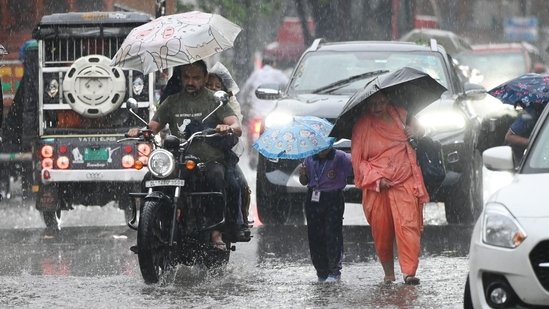New Delhi, May 3, 2024 – The national capital was thrown into disarray early Friday morning as an intense thunderstorm accompanied by heavy rainfall wreaked havoc across the city, leading to severe waterlogging, massive traffic disruptions, and tragic fatalities. The India Meteorological Department (IMD) had initially issued a yellow alert but escalated it to a red alert as the storm intensified, with wind speeds reaching a staggering 80 km/h.
Fatalities and Structural Damage
In a tragic incident, four individuals lost their lives, and one was injured when a massive tree collapsed onto a tubewell room in Kharkhari village, Dwarka. Local police confirmed the casualties, highlighting the dangers posed by the extreme weather conditions. Authorities rushed to clear debris and assist affected residents, but the damage was already done.
Across the city, uprooted trees and fallen branches blocked roads, compounding the chaos. The Delhi Fire Services reported multiple calls regarding uprooted trees in areas such as RK Puram, Lajpat Nagar, and Vasant Kunj. Municipal teams worked tirelessly to clear the roads, but the sheer volume of debris slowed progress.
Record Rainfall and Sudden Temperature Drop
The storm brought unprecedented rainfall within a short span. According to IMD data, Safdarjung, Delhi’s primary weather station, recorded 77 mm of rain between 2:30 AM and 8:30 AM—far exceeding the monthly average for May (30.7 mm). Other areas like Lodhi Road (78 mm), Pragati Maidan (71.5 mm), and Jaffarpur (67.5 mm) also experienced heavy downpours, leading to severe waterlogging.
The sudden storm also caused a dramatic drop in temperature. At Lodhi Road, the mercury plunged from 28.2°C at 5:15 AM to 20.7°C within just 15 minutes, a rare phenomenon for this time of year. RK Jenamani, a senior IMD scientist, noted that such intense May rainfall was last seen in 2021, when remnants of Cyclone Tauktae caused 119.3 mm of rain in a single day.
Traffic Snarls and Waterlogged Streets
Commuters faced nightmarish conditions as major roads turned into rivers. The infamous Minto Bridge underpass was submerged yet again, prompting Delhi Chief Minister Rekha Gupta to order an immediate inspection. Public Works Department (PWD) Minister Parvesh Verma later confirmed that water was drained within an hour, but not before traffic came to a standstill.
Other severely affected areas included:
- ITO Crossing (a major traffic bottleneck)
- Civil Lines and Preet Vihar (residential areas inundated)
- Bhairon Marg railway underpass (partially submerged)
- Pitampura and Moti Bagh (vehicles stranded)
Despite pre-monsoon drain-cleaning drives, the intensity of the rain overwhelmed the city’s drainage systems. Verma stated that all agencies—PWD, MCD, DJB, and NDMC—were working to clear waterlogged zones, but the scale of the downpour made relief efforts challenging.
Flight Operations Disrupted
Delhi’s Indira Gandhi International (IGI) Airport was not spared. Strong wind shear and heavy rain forced the diversion of three flights—one to Ahmedabad and two to Jaipur. Over 100 flights were delayed, causing frustration among passengers.
Airport officials, however, denied reports of structural damage to Terminal 3, stating:
“No infrastructure was harmed. Operations are normalizing, though delays may persist due to residual weather impacts.”
IMD’s Warning and Future Forecast
The IMD had initially predicted gusty winds (50 km/h) and light rain but upgraded the alert to red as the storm intensified. The department warned of moderate to heavy rain with severe thunderstorms (70-80 km/h winds) until 8:30 AM. While the worst has passed, the IMD forecasts scattered showers over the weekend, urging residents to stay cautious.
Political Reactions and Accountability
The opposition was quick to criticize the Delhi government for “lack of preparedness”, citing recurring waterlogging issues. Meanwhile, the ruling party defended its actions, emphasizing that “record unseasonal rainfall” was the primary cause.
What’s Next for Delhi?
With the monsoon season approaching, experts warn that poor drainage infrastructure could lead to more such crises. Authorities have promised 24/7 monitoring of flood-prone zones, but only time will tell if lessons have been learned.
For now, Delhiites are left dealing with the aftermath—drying homes, navigating traffic jams, and bracing for more unpredictable weather.
“Exciting News! Sejal News Network is now on WhatsApp Channels
Subscribe today by clicking the link and stay updated with the latest news!” Click Here
📰 Latest from Sejal News Network
- Daily Horoscope for 13 Dec 2025 — Saturday
- Akshaye Khanna Opens Up About Singlehood: A Life Built on Freedom and Clarity
- Daily Horoscope for 12 Dec 2025 — Friday
Published by Sejal News Network



